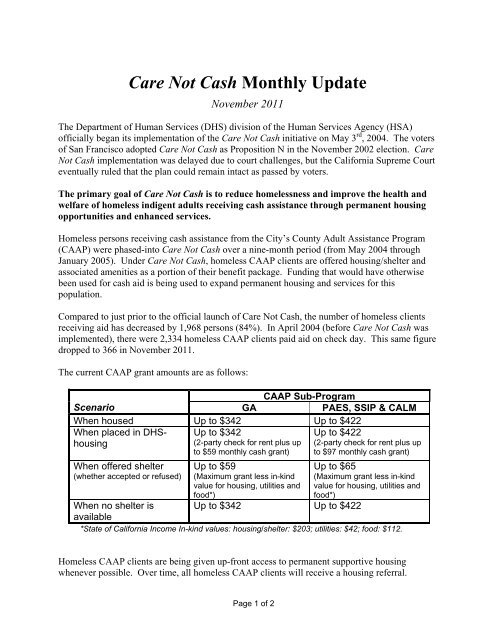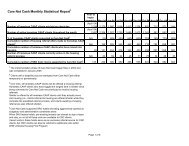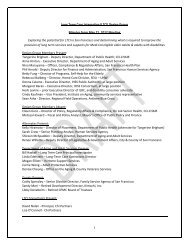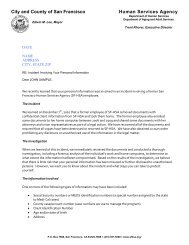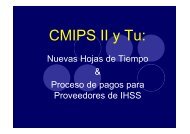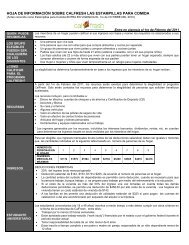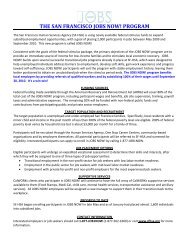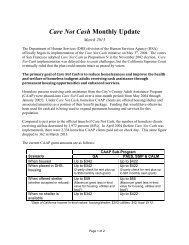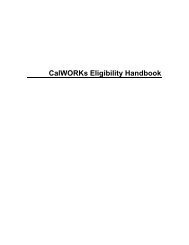Synopsis of Care Not Cash Implementation for - Human Services ...
Synopsis of Care Not Cash Implementation for - Human Services ...
Synopsis of Care Not Cash Implementation for - Human Services ...
Create successful ePaper yourself
Turn your PDF publications into a flip-book with our unique Google optimized e-Paper software.
<strong>Care</strong> <strong>Not</strong> <strong>Cash</strong> Monthly UpdateNovember 2011The Department <strong>of</strong> <strong>Human</strong> <strong>Services</strong> (DHS) division <strong>of</strong> the <strong>Human</strong> <strong>Services</strong> Agency (HSA)<strong>of</strong>ficially began its implementation <strong>of</strong> the <strong>Care</strong> <strong>Not</strong> <strong>Cash</strong> initiative on May 3 rd , 2004. The voters<strong>of</strong> San Francisco adopted <strong>Care</strong> <strong>Not</strong> <strong>Cash</strong> as Proposition N in the November 2002 election. <strong>Care</strong><strong>Not</strong> <strong>Cash</strong> implementation was delayed due to court challenges, but the Cali<strong>for</strong>nia Supreme Courteventually ruled that the plan could remain intact as passed by voters.The primary goal <strong>of</strong> <strong>Care</strong> <strong>Not</strong> <strong>Cash</strong> is to reduce homelessness and improve the health andwelfare <strong>of</strong> homeless indigent adults receiving cash assistance through permanent housingopportunities and enhanced services.Homeless persons receiving cash assistance from the City’s County Adult Assistance Program(CAAP) were phased-into <strong>Care</strong> <strong>Not</strong> <strong>Cash</strong> over a nine-month period (from May 2004 throughJanuary 2005). Under <strong>Care</strong> <strong>Not</strong> <strong>Cash</strong>, homeless CAAP clients are <strong>of</strong>fered housing/shelter andassociated amenities as a portion <strong>of</strong> their benefit package. Funding that would have otherwisebeen used <strong>for</strong> cash aid is being used to expand permanent housing and services <strong>for</strong> thispopulation.Compared to just prior to the <strong>of</strong>ficial launch <strong>of</strong> <strong>Care</strong> <strong>Not</strong> <strong>Cash</strong>, the number <strong>of</strong> homeless clientsreceiving aid has decreased by 1,968 persons (84%). In April 2004 (be<strong>for</strong>e <strong>Care</strong> <strong>Not</strong> <strong>Cash</strong> wasimplemented), there were 2,334 homeless CAAP clients paid aid on check day. This same figuredropped to 366 in November 2011.The current CAAP grant amounts are as follows:CAAP Sub-ProgramScenario GA PAES, SSIP & CALMWhen housed Up to $342 Up to $422When placed in DHShousingWhen <strong>of</strong>fered shelter(whether accepted or refused)Up to $342(2-party check <strong>for</strong> rent plus upto $59 monthly cash grant)Up to $422(2-party check <strong>for</strong> rent plus upto $97 monthly cash grant)Up to $59Up to $65(Maximum grant less in-kind (Maximum grant less in-kindvalue <strong>for</strong> housing, utilities and value <strong>for</strong> housing, utilities andfood*)food*)Up to $342 Up to $422When no shelter isavailable*State <strong>of</strong> Cali<strong>for</strong>nia Income In-kind values: housing/shelter: $203; utilities: $42; food: $112.Homeless CAAP clients are being given up-front access to permanent supportive housingwhenever possible. Over time, all homeless CAAP clients will receive a housing referral.Page 1 <strong>of</strong> 2
Emergency shelter is <strong>of</strong>fered to all homeless CAAP clients until they actually move into housing(i.e., clients referred to housing are <strong>of</strong>fered shelter while they complete the expedited referralprocess, and clients awaiting a housing referral are also <strong>of</strong>fered shelter). Homeless CAAP clientswho have logged the longest time in shelter are prioritized to receive housing referrals.Available <strong>Care</strong> <strong>Not</strong> <strong>Cash</strong> housing statistics through November ‘11 are as follows:• 3,691 homeless CAAP clients have moved into housing.• 9 homeless CAAP clients are currently active in the housing referral process.DHS’ Housing First Program, where clients have tenants’ rights, serves as the primary <strong>Care</strong> <strong>Not</strong><strong>Cash</strong> housing resource. Homeless CAAP clients may be referred to any Housing First Programhotel, although this group has exclusive access to the sub-group <strong>of</strong> hotels supported by <strong>Care</strong> <strong>Not</strong><strong>Cash</strong> funds. As <strong>of</strong> November 2011, there were 1,296 single room occupancy (SRO) hotel roomsbeing supported by <strong>Care</strong> <strong>Not</strong> <strong>Cash</strong>.In collaboration with DPH, <strong>Care</strong> <strong>Not</strong> <strong>Cash</strong> funding has allowed <strong>for</strong> the creation <strong>of</strong> a BehavioralHealth Roving Team. The goal <strong>of</strong> the Behavioral Health Roving Team is to provide medical andbehavioral health services to tenants living in the SRO Housing Program in order to stabilizethem in housing and avoid future episodes <strong>of</strong> homelessness. The case management part <strong>of</strong> theteam is supervised by UCSF/City-Wide Case Management and consists <strong>of</strong> two ClinicalSupervisors, five social workers and a substance abuse specialist. The medical part <strong>of</strong> the teamis comprised <strong>of</strong> a psychiatrist and two nurse practitioners employed and supervised by theDepartment <strong>of</strong> Public Health. The case management team outreaches to and engages clients thatare referred by on-site staff at the hotels. The team employs a range <strong>of</strong> interventions to helpstabilize residents, including mental health and substance abuse services, vocational andentitlements assistance, and skills groups. The DPH staff provides medical and psychiatricassessments on-site in the hotels and collaborates closely with the case management team in thedevelopment and implementation <strong>of</strong> treatment plans to best serve the needs <strong>of</strong> the hotelpopulation and enhance stability in housing. The Behavioral Health Roving Team also makesreferrals to the DPH Housing and Urban Health Clinic.Each month an updated version <strong>of</strong> this memo and the accompanying “<strong>Care</strong> <strong>Not</strong> <strong>Cash</strong> MonthlyStatistical Report” will be posted to the HSA web site (go to www.sfhsa.org and click on theright-hand menu “Data, Reports and Publications” link and then choose the “Housing andHomeless Reports” link).Page 2 <strong>of</strong> 2


